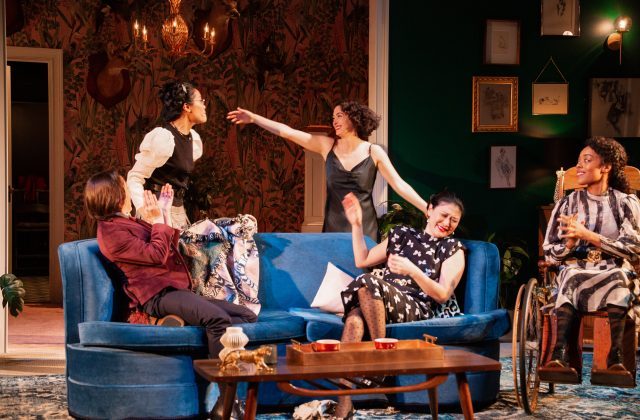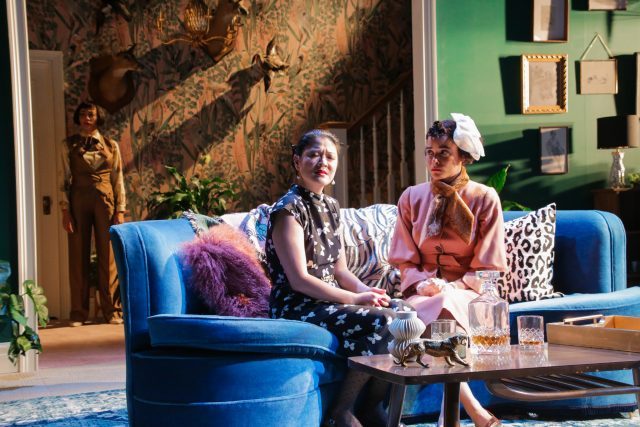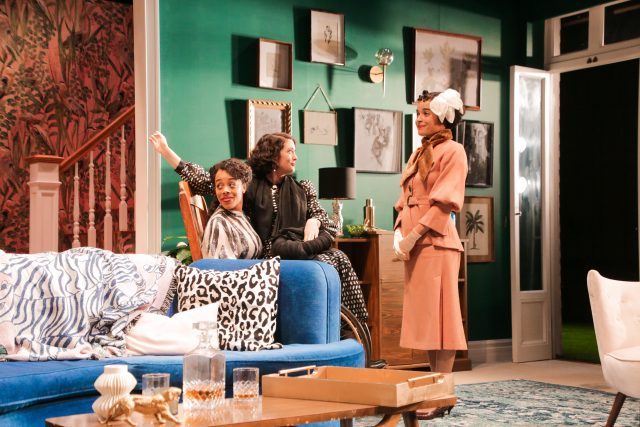
A group of diverse women gathers in an elegant home in María Irene Fornés’s astonishing Fefu and Her Friends (photo by Henry Grossman)
Theatre for a New Audience, Polonsky Shakespeare Center
262 Ashland Pl. between Lafayette Ave. & Fulton St.
Through December 8, $70-$90
866-811-4111
www.tfana.org
María Irene Fornés’s Fefu and Her Friends is a brilliant work of utter genius. Unseen in New York since its debut more than forty years ago, the revolutionary play is part art happening, part theatrical reinvention, now brought back in a dazzling revival by director Lileana Blain-Cruz that opened November 24 at Theatre for a New Audience’s Polonsky Shakespeare Center. It unfolds in three sections: The first on a conventional stage, with the audience watching from standard seating. For the second part, the audience gets up and moves around the space, following four scenes that occur simultaneously but separately, each offering close-up looks at the characters as the crowd goes from bedroom to study to kitchen to lawn before returning to their regular seats for the finale. It’s avant-garde promenade theater at its finest, embedding us in the abstract narrative while also making us feel like we’re spying on extremely personal moments.
The story takes place in the spring of 1935 in the elegant New England country home of Fefu (Amelia Workman), who has invited over seven women for a rehearsal of an upcoming school fundraiser. The title might sound like it’s a family-friendly show, but it’s an insightful and often shocking mature dissection of women’s roles in society, both with and without men. “My husband married me to have a constant reminder of how loathsome women are,” Fefu tells Cindy (Jennifer Lim) and Christina (Juliana Canfield) at the very beginning, shortly before firing a double-barrel shotgun in the offstage direction of Phillip, her husband. The gun might or might not be loaded. “She’s crazy,” Christina says. “A little. She has a strange marriage,” Cindy replies.

Cindy (Jennifer Lim) and Christina (Juliana Canfield) are concerned as Fefu (Amelia Workman) stands in the back in TFANA revival (photo by Gerry Goodstein)
They are soon joined by Emma (Helen Cespedes), Sue (Ronete Levenson), Paula (Lindsay Rico), Cecilia (Carmen Zilles), and Julia (Brittany Bradford), the eight of them as a unit representing the many aspects of the feminine while avoiding trite stereotypes. Over the course of two thrilling hours, the women talk about love affairs, genitals, pain, anarchist Voltairine de Cleyre, actress, writer, and teacher Emma Sheridan Fry, happiness, and fear, but they are not the catty characters of Clare Boothe Luce’s The Women or the melodramatic ladies of Steel Magnolias. They are also not heroic or iconic figures; they each have their flaws that they either flaunt or hide. No men appear in the play, nor are they the primary subject of discussion, but they hover on the periphery. “I still like men better than women,” Fefu says. “I envy them. I like being like a man. Thinking like a man. Feeling like a man. They are well together. Women are not.” Fefu is arguably the most masculine of the women, shooting guns and fixing a broken toilet. At the other end of the spectrum is the wheelchair-bound Julia, who was paralyzed when standing near a deer that was shot, even though no bullet ever struck her. Thus, in Fornés’s world, women are both hunter and hunted. Adam Rigg’s sets further that idea, as all the rooms feature elements of nature, from wallpaper decorated with plants and flowers to animal lamps, from leaves surrounding Julia’s bed to drawings of plants and animals — along with men and women — hung in the living room.

Julia (Brittany Bradford), Emma (Helen Cespedes), and Christina (Juliana Canfield) share a happy moment in María Irene Fornés masterpiece (photo by Gerry Goodstein)
“We each have our own system of receiving information, placing it, responding to it,” Cecilia says at the start of part three. “That system can function with such a bias that it could take any situation and translate it into one formula. That is, I think, the main reason for stupidity or even madness, not being able to tell the difference between things.” That statement succinctly sums up how the audience experiences the nonformulaic play, which has constructed a unique theatrical environment, “immersive” well before that became its own genre. Montana Levi Blanco’s costumes dazzle, while Palmer Hefferan’s sound design during the second part results in a cacophony of voices as bits of conversation from the other concurrent scenes can be picked up, like in real life. Two-time Obie winner Blain-Cruz (Marys Seacole, The Death of the Last Black Man in the Whole Entire World) beautifully leads the engaging cast and the audience through the Cuban-born Fornés’s (Drowning, The Conduct of Life) masterpiece, which earned her the second of her nine Obies. It’s a stirring journey through time and space, a one-of-a-kind play that must be seen; it will blow your mind.